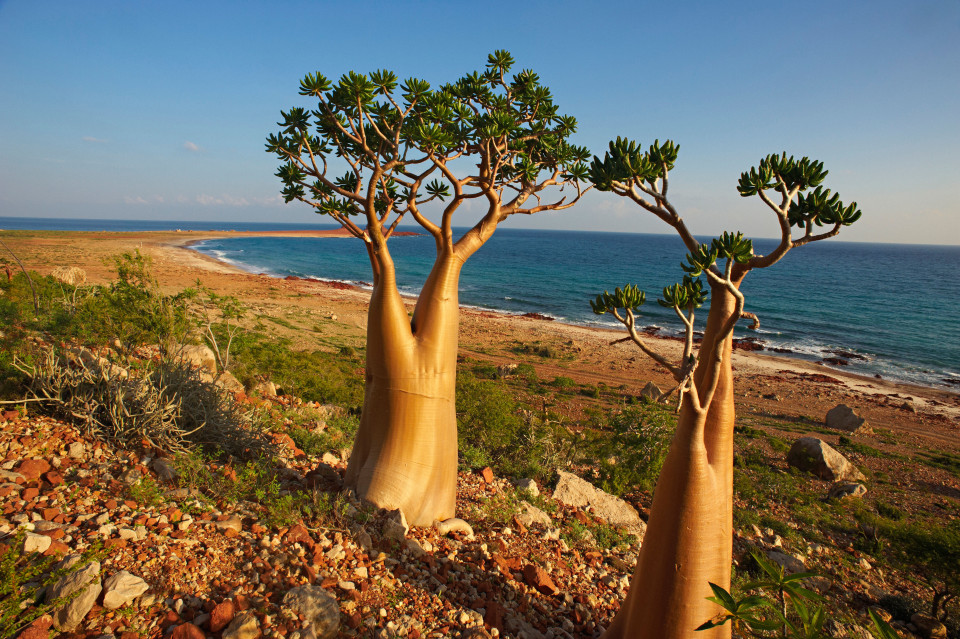History & Heritage
4.19.2022
World Heritage Day: 5 little-known historical sites in the Arab world

While the sites of the pyramids of Giza and Petra are known as “historic sites of the Arab world”, this vast region is full of other treasures that are less well known but just as rich to discover. In honor of yesterday’s International World Heritage Day, let’s discover 5 incredible UNESCO World Heritage Sites that you may not have heard of yet!
1. The Socotra Archipelago – Yemen
The Socotra archipelago, spread over 250 km in the northwestern Indian Ocean, comprises four islands and two rocky islets that seem to extend the Horn of Africa. The Socotra dragon tree, named after the archipelago, stands as a symbol of its rich and unique biodiversity.

Indeed, the archipelago embodies a true natural paradise with its great diversity of plants and its rate of endemism. 37% of the 825 species of plants present, 90% of the species of reptiles and 95% of the species of land snails are not found anywhere else in the world.
The site is also distinguished by the important migrations of bird populations, some species of which are threatened with extinction. As for marine life, Socotra is home to more than 250 species of reef-building corals, 730 species of coastal fish and 300 species of crabs, lobsters and shrimps.
2. The city of Hatra – Iraq
A great fortified city under the influence of the Parthian Empire and capital of the first Arab kingdom, Hatra is located in northern Iraq and dates back over 2000 years. Hatra resisted the Romans twice, in 116 and in 198, thanks to its wall reinforced with towers. The remains of the city, and in particular the temples where Greek and Roman architecture is combined with decorative elements of oriental origin, testify to the greatness of its civilization.

Thanks to the efforts of the Iraqi authorities, its restoration is progressing and the country is proudly reconnecting with its roots. After its partial destruction, the first works were focused on the rescue of its foundations, as well as statues and rooms in the process of collapsing.
3. Wadi Rum – Jordan
The site of Wadi Rum, listed as a mixed natural and cultural site, covers 74,000 hectares in southern Jordan. It is a spectacular desert landscape with canyons, natural arches, cliffs, ramps and caves.

The presence of 25,000 petroglyphs, 20,000 engraved inscriptions and archaeological remains testify to 12,000 years of human occupation and interaction with the natural environment. These imprints trace the evolution of human thought and the beginnings of alphabetic writing. In addition, they provide information on pastoral, agricultural and urban activities in the region.
4. Tassili n’Ajjer – Algeria

Huge plateau located in the south-east of Algeria on the borders of Libya, Niger and Mali, Tassili n’Ajjer has a great geological interest since it shelters one of the most important sets of prehistoric rock art of the world. The site is indeed made exceptional by the density of its paintings and engravings, and the existence of many remains dating from 6000 BC to the first centuries of our era. These 15,000 drawings and engravings attest to human evolution but also to the migrations of the fauna and climatic conditions. The site also offers an aesthetic interest to its visitors. Its “forests of rocks” give the impression of a lunar landscape, unique in the world.
5. The Oasis of Al-Ahsa – Saudi Arabia
The site of Al-Ahsa concentrates the largest oasis in the world. With its 2.5 million palm trees providing welcome shade and its crystal clear springs, the Al-Hassa Oasis appears as a verdant paradise in the heart of the harsh plains of the Rub al Khali, the “Empty Quarter”. For several millennia, the fertile lands of the region have attracted merchants and caravans traveling along ancient trade routes. The site thus facilitated links throughout the Arabian Peninsula and beyond and provided a resting place for early pilgrims en route to Mecca.

Now a UNESCO World Heritage Site, al-Hassa Oasis is home to numerous archaeological sites that bear witness to the presence of human beings in the Neolithic period. It is one of the most captivating tourist destinations in Saudi Arabia. This unique geo-cultural landscape is also among the outstanding examples of human interaction with the environment.
popular

